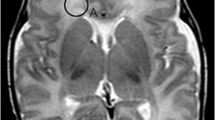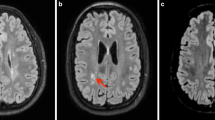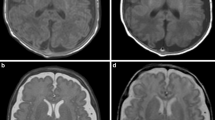Abstract
Background
Diffuse damage to the periventricular white matter has recently been suggested to be a cause of the cognitive deficits seen following preterm birth. It is unclear whether this form of injury can be visualised on MR imaging, but one group has described diffuse excessive high signal intensity (DEHSI) as a possible form of diffuse white matter injury. This finding is dependant on window imaging and the subjective assessment of the reviewer, but little data have been published on the degree of subjectivity on its appearance among raters.
Objective
To assess the subjectivity of DEHSI on conventional and ultrafast T2-weighted MR imaging following preterm birth.
Materials and methods
An observational study of 40 preterm infants who had MR imaging of the brain around term-equivalent age, including conventional fast spin-echo (FSE) and ultrafast single-shot fast spin-echo (SSFSE) T2-weighted sequences in the axial plane. Images were anonymised and scored twice by four observers for the presence of DEHSI. Inter- and intra-observer agreement were calculated.
Results
Sixty-five percent of conventional and 100% of the ultrafast images were of diagnostic quality. DEHSI was noted in between 0% and 69.2% of conventional images and 27.5–90% of the ultrafast images. Inter- and intra-observer agreement ranged from none to moderate.
Conclusion
The visual appearances of DEHSI on conventional FSE and ultrafast SSFSE T2-W images are highly subjective, limiting its clinical application.

Similar content being viewed by others
References
Wood NS, Marlow N, Costeloe K et al (2000) Neurologic and developmental disability after extremely preterm birth. N Engl J Med 343:378–384
Marlow N, Wolke D, Bracewell MA et al (2005) Neurologic and developmental disability at six years of age after extremely preterm birth. N Engl J Med 352:9–19
Fily A, Pierrat V, Delporte V et al (2006) Factors associated with neurodevelopmental outcome at 2 years after very preterm birth: the population-based Nord-Pas-de-Calais EPIPAGE cohort. Pediatrics 117:357–366
Bhutta AT, Cleeves MA, Casey PH et al (2002) Cognitive and behavioral outcomes of school-aged children who were born preterm: a meta-analysis. JAMA 288:728–737
Caravale B, Tozzi C, Albino G et al (2005) Cognitive development in low risk preterm infants at 3–4 years of life. Arch Dis Child Fetal Neonatal Ed 90:F474–F479
Reijneveld SA, de Kleine MJ, van Baar AL et al (2006) Behavioural and emotional problems in very preterm and very low birthweight infants at age 5 years. Arch Dis Child Fetal Neonatal Ed 91:F423–F428
Woodward LJ, Anderson PJ, Austin NC et al (2006) Neonatal MRI to predict neurodevelopmental outcomes in preterm infants. N Engl J Med 355:685–694
Aida N, Nishimura G, Hachiya Y et al (1998) MR imaging of perinatal brain damage: comparison of clinical outcome with initial and follow-up MR findings. AJNR 19:1909–1921
Serdaroglu G, Tekgul H, Kitis O et al (2004) Correlative value of magnetic resonance imaging for neurodevelopmental outcome in periventricular leukomalacia. Dev Med Child Neurol 46:733–739
Olsen P, Paakko E, Vainionpaa L et al (1997) Magnetic resonance imaging of periventricular leukomalacia and its clinical correlation in children. Ann Neurol 41:754–761
Hart AR, Whitby EH, Griffiths PD et al (2008) Magnetic resonance imaging and developmental outcome following preterm birth: review of current evidence. Dev Med Child Neurol 50:655–663
Inder TE, Wells SJ, Mogridge NB et al (2003) Defining the nature of the cerebral abnormalities in the premature infant; a qualitative magnetic resonance imaging study. J Pediatr 143:171–179
Hamrick SE, Miller SP, Leonard C et al (2004) Trends in severe brain injury and neurodevelopmental outcome in premature newborn infants: the role of cystic periventricular leukomalacia. J Pediatr 145:593–599
Volpe JJ (2001) Neurobiology of periventricular leukomalacia in the premature infant. Pediatr Res 50:553–562
Volpe JJ (2003) Cerebral white matter injury of the premature infant-more common than you think. Pediatrics 112:176–180
Back SA, Riddle A, McClure MM (2007) Maturation-dependent vulnerability of perinatal white matter in premature birth. Stroke 38:724–730
Gilles FH, Gomez IG (2005) Developmental neuropathology of the second half of gestation. Early Hum Dev 81:245–253
Rutherford MA (2002) MRI of the neonatal brain. WB Saunders Ltd, London
Maalouf EF, Duggan PJ, Rutherford MA et al (1999) Magnetic resonance imaging of the brain in a cohort of extremely preterm infants. J Pediatr 135:351–357
Counsell SJ, Allsop JM, Harrison MC et al (2003) Diffusion-weighted imaging of the brain in preterm infants with focal and diffuse white matter abnormality. Pediatrics 112:1–7
Dyet LE, Kennea N, Counsell SJ et al (2006) Natural history of brain lesions in extremely preterm infants studied with serial magnetic resonance imaging from birth and neurodevelopmental assessment. Pediatrics 118:536–548
Counsell SJ, Rutherford MA, Cowan FM et al (2003) Magnetic resonance imaging of preterm brain injury. Arch Dis Child Fetal Neonatal Ed 88:F269–F274
Counsell SJ, Shen Y, Boardman JP et al (2006) Axial and radial diffusivity in preterm infants who have diffuse white matter changes on magnetic resonance imaging at term-equivalent age. Pediatrics 117:376–386
Miller SP, Cozzio CC, Goldstein RB et al (2003) Comparing the diagnosis of white matter injury in premature newborns with serial MR imaging and transfontanel ultrasonography findings. AJNR 24:1661–1669
Fleiss JL (1981) The measurement of interrater agreement. In: Statistical methods for rates and proportions, 2nd edn. Wiley, New York, pp 212–236
Landis JR, Koch GG (1977) The measurement of observer agreement for categorical data. Biometrics 33:159–174
Cheong JL, Thompson DK, Wang HX et al (2009) Abnormal white matter signal on MR imaging is related to abnormal tissue microstructure. AJNR 30:623–628
Hart AR, Whitby EH, Clark SJ et al (2010) Diffusion weighted imaging of the cerebral white matter and cerebellum following preterm birth. Dev Med Child Neurol Jan 28 [Epub ahead of print]
Cornette LG, Tanner SF, Ramenghi LA et al (2002) Magnetic resonance imaging of the infant brain: anatomical characteristics and clinical significance of punctate lesions. Arch Dis Child Fetal Neonatal Ed 86:F171–F177
Miller SP, Ferriero DM, Leonard C et al (2005) Early brain injury in premature newborns detected with magnetic resonance imaging is associated with adverse early neurodevelopmental outcome. J Pediatr 147:609–616
Nanba Y, Matsui K, Aida N et al (2007) Magnetic resonance imaging regional T1 abnormalities at term accurately predict motor outcome in preterm infants. Pediatrics 120:e10–e19
Krishnan ML, Dyet LE, Boardman JP et al (2007) Relationship between white matter apparent diffusion coefficients in preterm infants at term-equivalent age and developmental outcome at 2 years. Pediatrics 120:e604–e609
Arzoumanian M, Mirmiran M, Barnes PD et al (2003) Diffusion tensor brain imaging findings at term-equivalent age may predict neurologic abnormalities in low birth weight preterm infants. AJNR 24:1646–1653
Partridge SC, Mukherjee P, Henry RG et al (2004) Diffusion tensor imaging: serial quantitation of white matter tract maturity in premature newborns. Neuroimage 22:1302–1314
Huppi PS, Maier SE, Peled S et al (1998) Microstructural development of human newborn cerebral white matter assessed in vivo by diffusion tensor magnetic resonance imaging. Pediatr Res 44:584–590
Dudink J, Lequin M, van Pul C et al (2007) Fractional anisotropy in white matter tracts of very-low-birth-weight infants. Pediatr Radiol 37:1216–1223
Huppi PS, Murphy B, Maier SE et al (2001) Microstructural brain development after perinatal cerebral white matter injury assessed by diffusion tensor magnetic resonance imaging. Pediatrics 107:455–460
Yung A, Poon G, Qui DQ et al (2007) White matter volume and anisotropy in preterm children: a pilot study of neurocognitive correlates. Pediatr Res 61:732–736
Counsell SJ, Edwards AD, Chew ATM et al (2008) Specific relations between neurodevelopmental abilities and white matter microstructure in children born preterm. Brain 131:3201–3208
Constable RT, Ment LR, Vohr BR et al (2008) Prematurely born children demonstrate white matter microstructural differences at 12 years of age, relative to term control subjects: an investigation of group and gender effects. Pediatrics 121:306–316
Andrews JS, Ben-Shachar M, Yeatman JD et al (2009) Reading performance correlates with white-matter properties in preterm and term children. Dev Med Child Neurol Sep 11 [Epub ahead of print]
Son SM, Park SH, Moon HK et al (2009) Diffusion tensor tractography can predict hemiparesis in infants with high risk factors. Neurosci Lett 451:94–97
Rose J, Mirmiran M, Butler EE et al (2007) Neonatal microstructural development of the internal capsule on diffusion tensor imaging correlates with severity of gait and motor deficits. Dev Med Child Neurol 49:745–750
Rose J, Butler EE, Lamont LE et al (2009) Neonatal brain structure on MRI and diffusion tensor imaging, sex, and neurodevelopment in very-low-birthweight preterm children. Dev Med Child Neurol 51:526–535
Berman JI, Mukherjee P, Partridge JC et al (2005) Quantitative diffusion tensor MRI fiber tractography of sensorimotor white matter development in premature infants. Neuroimage 27:862–871
Partridge SC, Mukherjee P, Berman JI et al (2005) Tractography-based quantitation of diffusion tensor imaging parameters in white matter tracts of preterm newborns. J Magn Reson Imaging 22:467–474
Murakami A, Morimoto M, Yamada K et al (2008) Fiber-tracking techniques can predict the degree of neurologic impairment for periventricular leukomalacia. Pediatrics 122:500–506
Bassi L, Ricci D, Volzone A et al (2008) Probabilistic diffusion tractography of the optic radiations and visual function in preterm infants at term equivalent age. Brain 131:573–582
Acknowledgements
The authors wish to thank Dr Dan Connolly for his help with this study.
Financial disclosure
Dr Hart’s post is funded by a grant from the Jessop Baby Fund. The funding source had no involvement in study design, data collection, interpretation or decision to publish.
Author information
Authors and Affiliations
Corresponding author
Rights and permissions
About this article
Cite this article
Hart, A.R., Smith, M.F., Rigby, A.S. et al. Appearances of diffuse excessive high signal intensity (DEHSI) on MR imaging following preterm birth. Pediatr Radiol 40, 1390–1396 (2010). https://doi.org/10.1007/s00247-010-1633-7
Received:
Revised:
Accepted:
Published:
Issue Date:
DOI: https://doi.org/10.1007/s00247-010-1633-7




